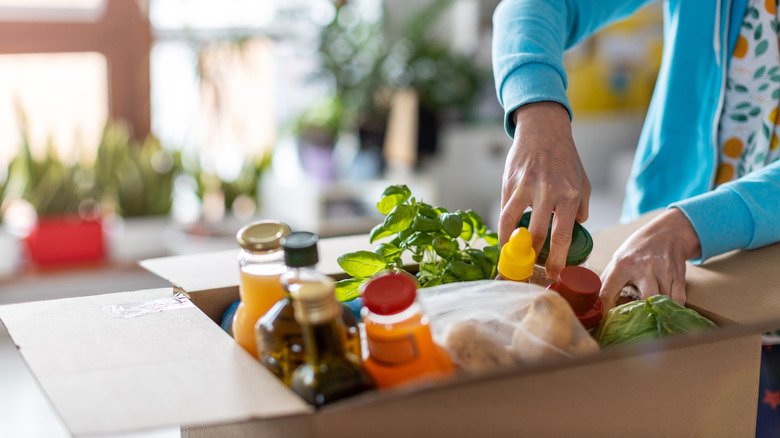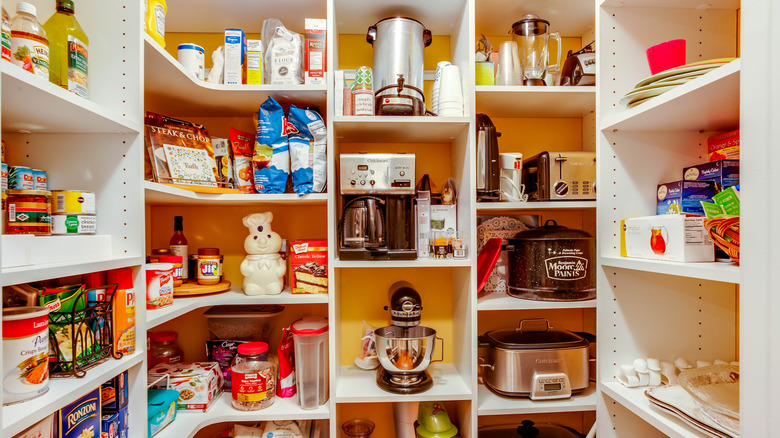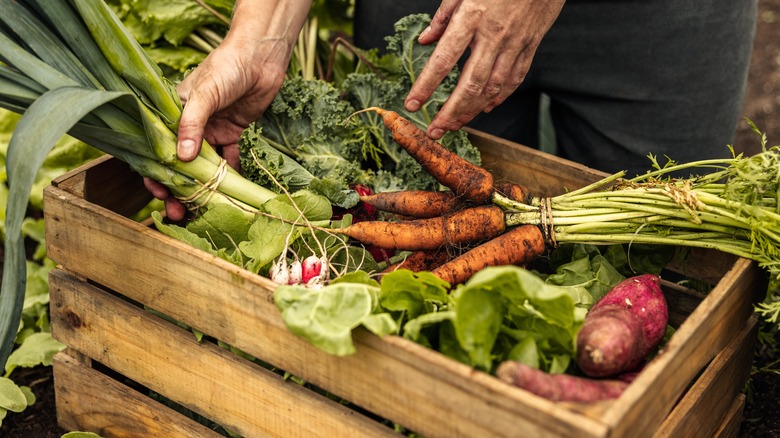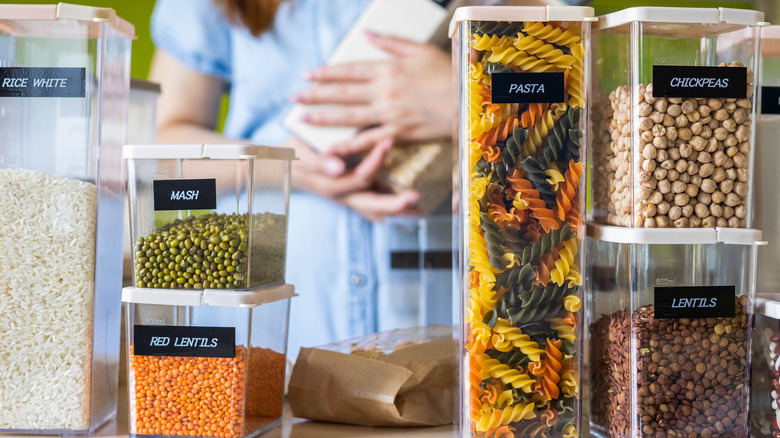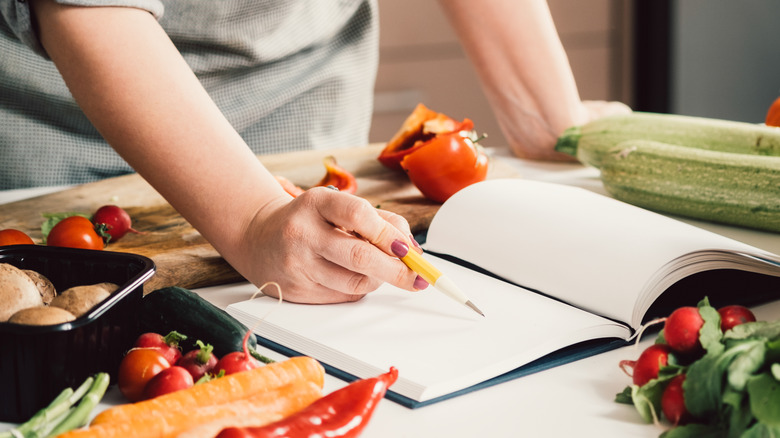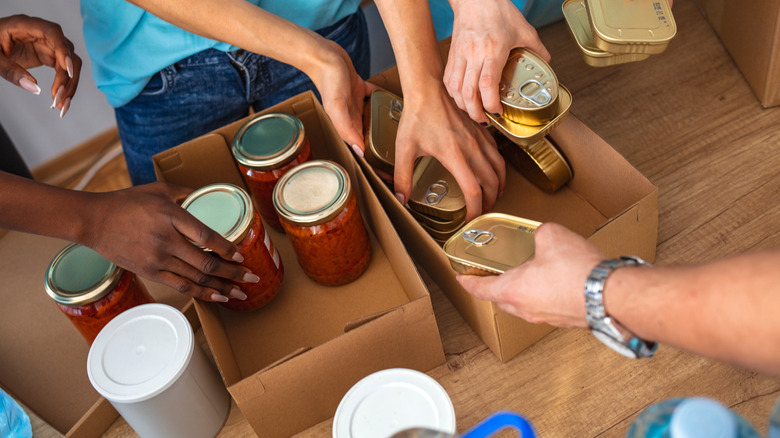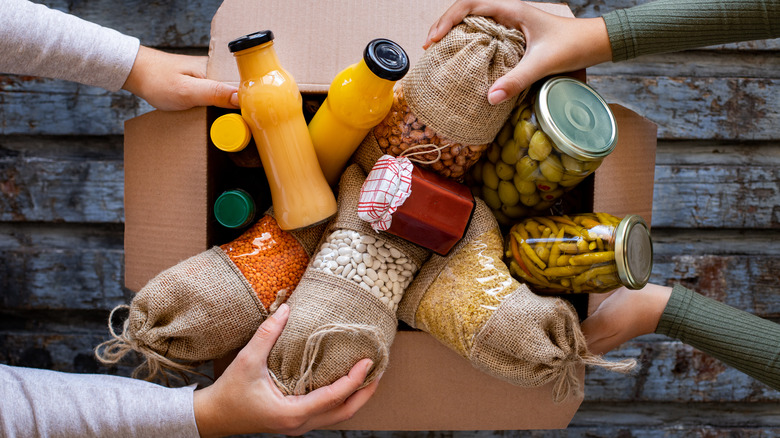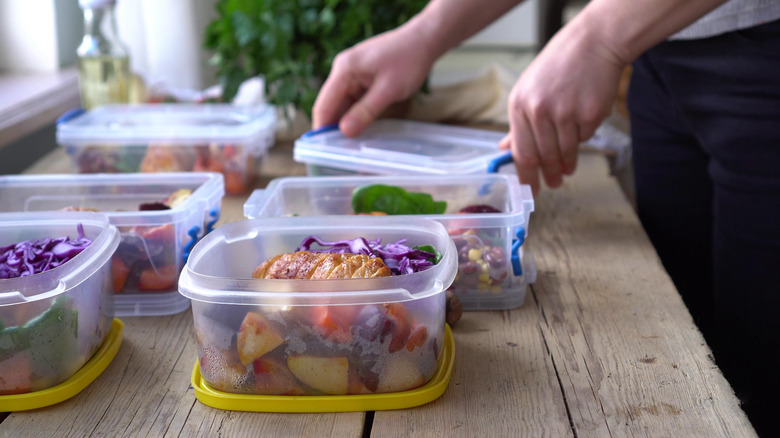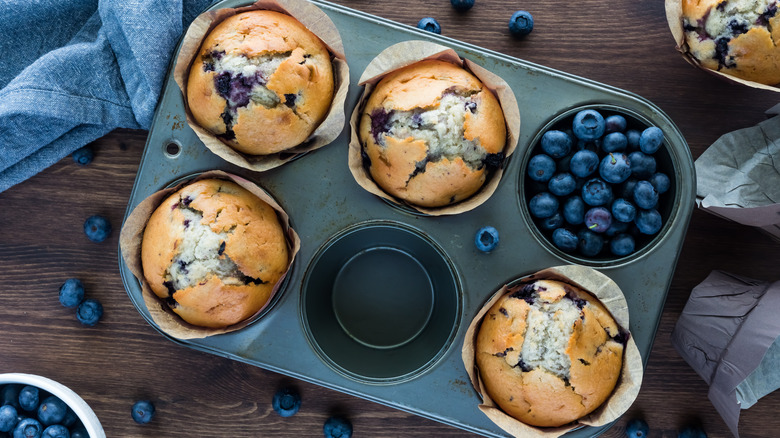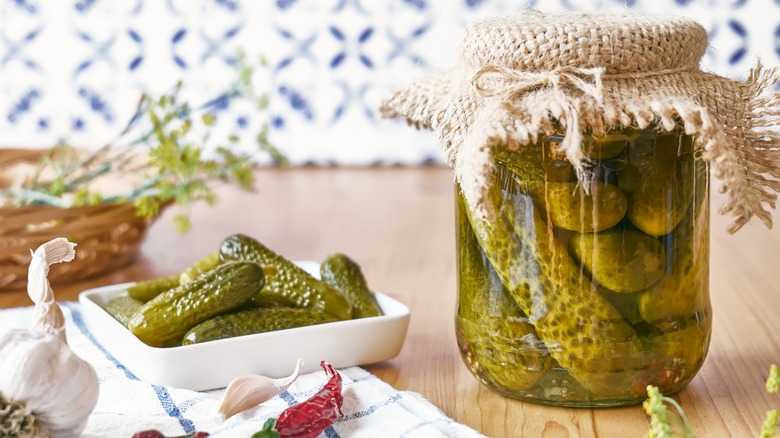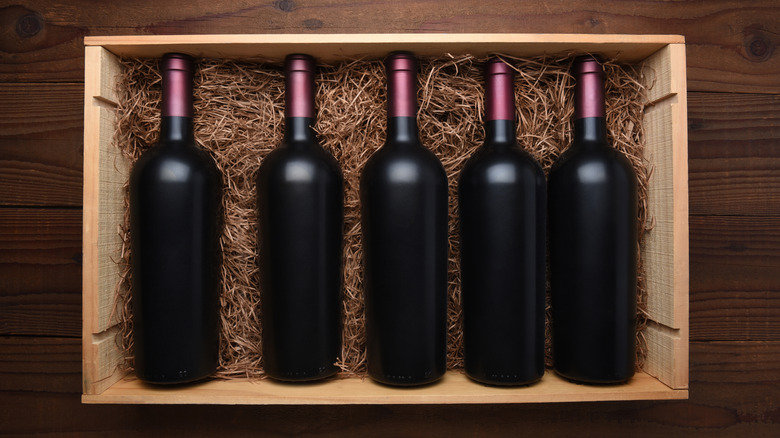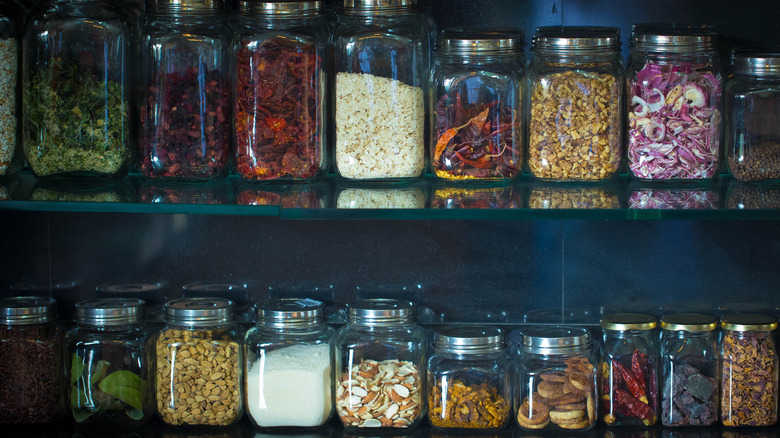12 Tips For Cleaning Out Your Pantry And Fridge Before A Move
The worst part of moving is, without a doubt, packing. Here is a non-exhaustive list of things that might run through your head while doing so: How in the world do I own this much stuff? How did I move all this stuff here in the first place? Why do I own enough spices for a small army?
There's a lot that goes into leaving one home for another. And the kitchen is often the silent killer. There's baking goods, canned soups from that one time you got sick last year, and ingredients you needed for one recipe and then never again. So when it comes to packing your fridge and pantry, it's valid to feel overwhelmed by all the small items. Read below to discover our tips and tricks for making the move (at least when it comes to food) easier, and an opportunity to experiment with new recipes!
Cook more, pack less.
Take stock of what you have
Appreciate the pun? We know you're probably stressed out right now and could use a good, silly joke. But in all seriousness, opening that fridge to half-filled jars and herbs wilting in green water can be extremely overwhelming. To streamline the process, make a list of what you have. Tally the amount of each, leave a note saying how much you have left, and whether you're going to pack it or want to finish it off.
With a list, you have a clear idea of everything in the fridge (and don't forget the freezer, your pantry, and any cabinets or drawers where food could hide away behind closed doors). For the next few days or weeks as you're finalizing everything, work from this list. Try not to buy anything new, and instead get creative using up what you have. You could even make an actual stock: Try this easy instant pot chicken stock or this corn stock to use up any leftover summer corn.
Kill your darlings
You have to eat the perishables first — those gorgeous beefsteak tomatoes, plump and juicy peaches, bright fresh herbs, hearty meats, and tangy cheese. Whether you're ready to admit it to yourself or not, the final days before moving are going to be fueled by takeout and pre-made dishes bought from the supermarket. Moving isn't exactly the time to show off your Michelin-grade recipes. So enjoy what will go bad now, when it's still good.
If you need some help deciding what to make with those fresh vegetables before they turn, articles like this one on the best grilled vegetable recipes is a great place to start. Here you'll find recipes for mushrooms, asparagus, corn, eggplant, plantains, and much more. Then it's an easy hop over to finding recipes for perishable meats and fishes. For instance, use up your ground beef — either fresh or frozen — to make our classic meatloaf recipe, which uses up two pounds of meat!
Label items and pre-pack
This is when you'll want to break out that label maker. Similar to making a list, knowing what you have and being able to see it can be really life-changing when it comes to staying on top of things. The mysterious mass of grocery goods in your pantry and fridge become identifiable ingredients to continue working with until the moving date comes. Plus, you'll look extra chef-y labeling everything with painter's tape. With everything labeled, you can then begin to pre-pack the items that you won't need in the next few days.
We recommend starting with any unopened containers and glass jars. This is because you can get a head start on packing up the non-perishables, and letting them sit in your closet (or any open space you can find). And since they're labeled already, you won't forget what you have. But if something isn't terribly perishable, and can typically make a short journey, just label that for now and keep it in your fridge. You may be sacrificing flavor in the long run, but when it comes to moving, sacrifices must be made.
Experiment with what you have
Try out new recipes you never had before! Maybe this homemade Chilaquiles recipe is calling out to you, which will use up avocado, crema, onions, cilantro, radishes, and cheese — talk about a perishables knockout! Or something like Classic Baked Ziti can feed you for days leading up to the big move.
Use the list you compiled earlier and type the ingredients you have on hand into a search engine. What comes up? Will it use up other ingredients? Does it not require you adding something new to the mix? Then go for it. Or, take to your own in the kitchen and let the ingredients inspire you. We always recommend creating a meal with starch, protein, and vegetables. Having that as a guide can really go a long way in crafting your own meals. Let the flavors inspire you, take inspiration from other recipes, but ultimately have fun. And remember that cooking is supposed to be exciting.
Donate unopened and nonperishable goods
This should be a no-brainer, and often is. Any food and homeless shelters in your area need all the help they can get right now. Donating is a great way to help your community while making the packing process easier on you. Some neighborhoods have even built their own food banks since the pandemic hit, which often contain shelves for easy drop-off and retrieval. They're called "lawn food pantries" and offer an easy, accessible way to care for one another.
But when it comes to established food pantries and shelters, you have to be careful with what you donate. The rule of thumb is that you don't want to donate anything that's been opened or half-used, and nothing perishable. These goods have to be able to stand storage, and keep everyone handling and receiving them safe. So this is a great opportunity to donate soup cans, boxes or rice, cereals, and anything along those lines.
Divvy up the other things to friends and family
You can't donate anything that's been opened or partially used to food banks and homeless shelters (nor would you want to). But, you most likely have some opened things in your fridge that just aren't going to make the cut. Maybe there's still half a parmesan cheese container left that you simply don't have the space for, but neither the heart to throw it out. Or a bunch of bananas that won't survive the trip. What to do!
Reach out to your friends and family. They may not be thrilled about getting the last half of an onion, but they could be persuaded to a big bag of extra ripe peaches just begging to be cooked into a cobbler. To make things fun, you could even print out recipes for the gifted ingredients. Once you've exhausted all interested parties, it is time, however, to move onto tossing any uneaten, unclaimed fruits and veg into the compost.
Decide what you're eating ahead of time
Don't forget you still need to eat! Trust us, we've all gotten too ahead of ourselves with packing and accidentally stored away everything but the clothes on our backs. While you can maybe get away with wearing the same pants for three days in a row, you definitely can't not eat for that amount of time (nor will you want to spend all that money on takeout).
So before packing everything into boxes and coolers, make a meal plan for the week or last few days before you move. Most importantly, do this for the day of the move. What are you having for breakfast? Can you use up the last two eggs in the carton then? What about bread? Or maybe you like oatmeal in the mornings. Do you have oats? A kettle for hot water? If you like cinnamon, maybe try separating a couple of tablespoons into a smaller container so you can have some comfort before hitting the road.
Bake for a small army
We know the last thing you want to do while packing away your home is set aside time to cook for family and friends. However, when it comes to diminishing the amount of food you have to take with you, it might actually be worth the effort. And with a dessert like this Easy Sopapilla recipe, it won't actually take that much. All you need are tortillas, powdered sugar, and enough vegetable oil for frying. The crispy, sweet bites you get as a result will also be a welcome break from packing.
Another option, if you need to use up a handsome amount of flour, is to bake bread. Bread inherently has breaks built in — often in the form of giving the dough time to rise — so you can split up your packing shifts according to your recipe. This No-Knead Rosemary Bread recipe is not only delicious but simple, and uses up a remarkable three cups of flour!
Transform the perishables
Time to get scientific. If you're unable to use up all your perishables before moving, then you have a great opportunity to learn about preservation methods! Can you freeze-dry some of your fruits, or maybe dehydrate them into leathers? Or you can try canning jams and jellies, ferments and more! We know it might seem like adding more work onto what you already have to do, but you'll save money, decrease waste, and make yourself non-perishable snacks for the drive.
When it comes to drying food, you want to keep three things in mind: consistent warm temperatures, air circulation, and low humidity. So this might not be a great option if you're moving in the middle of July. As for canning, it may seem scary at first, but remember that all you need to do is follow the directions. Putting food up for storage has become increasingly popular over the years, and has a long history. Stick to tested recipes and how-tos, and you'll be fine!
Get good at Tetris
Some items simply won't be used up before you go, which means you have to pack them. Most notably, your spice drawer or rack will probably be bursting at the seams. These pesky bottles are often all different shapes and sizes, making packing difficult (not to mention frustrating when what should be a satisfying puzzle game becomes mis-matched boxes jostling next to each other in a too-big cardboard box). So squeeze them in wherever you can, any which way you can.
Another thing to consider is packing up beer or wine. Again, we run into the issue of different heights, widths, etc. Not to mention they're often made of glass — except for drinks that come in aluminum cans, which can be just thrown in willy nilly if you're not worried about an explosion later. For safe traveling with beer and wine, place the bottles in socks or wrap sweaters around them (a great way to lessen another section of the packing load).
Consolidate doubles
It's bound to happen: you have two containers of one spice, both half finished. Maybe it's the baking powder you forgot you already had and bought another. Do you use up space packing both? Of course not. This is why we recommend going through everything and trying to consolidate those duplicates into one. You can even use the same glass or plastic bottles they come in! However, if they're not large enough, you can purchase plain spice bottles online or at home goods stores.
It's not just spices. Could be peanut butter, honey, baking supplies, tea bags ... anything, really! Do you have earl gray from two different brands? For the sake of your sanity when packing, just chuck those into one box. You can reorganize everything at the final destination. Why not go all out and buy matching sets of glass canisters? Streamline your process while imbuing a stylish yet clean aesthetic for your new kitchen.
Say goodbye
Unfortunately, there will be some things you just can't save. You can try composting them, which we'd recommend if you're dealing with fruits, vegetables, kitchen scraps, coffee grounds, and compostable tea bags. Just make sure you aren't composting meat, since it can contain salmonella and E. coli. Composting is a great option for the environment, allowing you to turn spent food into nutrient-rich soil for yourself or the community.
Speaking of which, if you don't want to leave your compost unattended or move with it (understandable), look for a community-led compost system in your area. Most cities, both small and large, have their own nowadays. But if you're unable to or don't have access to a community composter, then the trash will have to do. That's okay. At some point, you've exhausted all options, made the lists, baked and canned, and all you want is to check the kitchen off your list. If that requires a few extra trash bags, so be it.
